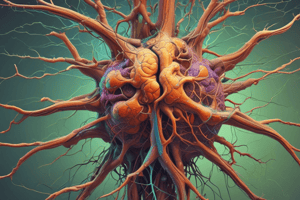Podcast
Questions and Answers
Explain the primary functions of the lymphatic system.
Explain the primary functions of the lymphatic system.
The primary functions of the lymphatic system include emptying extracellular fluid into the bloodstream, managing fluid levels in the body, absorbing fats from our diets, and transporting lipids and lipid-soluble vitamins.
What are the primary and secondary lymphoid tissues and their functions?
What are the primary and secondary lymphoid tissues and their functions?
The primary lymphoid tissues, such as the thymus and bone marrow, are responsible for creating and maturing lymphocytes. The secondary lymphoid tissues, including lymph nodes, tonsils, MALT, Peyer's patches, and the spleen, are where extracellular fluid is drained and immune responses occur.
Describe the structure and function of lymphatic capillaries.
Describe the structure and function of lymphatic capillaries.
Lymphatic capillaries are found between cells, closed at one end, and anchored by filaments to attach lymphatic endothelial cells to tissues. They help manage interstitial pressure and carry dietary lipids in the form of chyle.
What are the main functions and components of lymph nodes?
What are the main functions and components of lymph nodes?
Explain the transport mechanisms and pathways of lymph in the body.
Explain the transport mechanisms and pathways of lymph in the body.
Flashcards are hidden until you start studying
Study Notes
Lymphatic System Functions
- The primary function of the lymphatic system is to defend the body against disease and infection by removing pathogens, toxins, and other foreign substances
- It also plays a crucial role in lipid absorption and transportation from the digestive system
- The lymphatic system helps to maintain fluid balance and blood pressure by returning interstitial fluid to the bloodstream
Lymphoid Tissues
- Primary Lymphoid Tissues: These are the sites where lymphocytes mature and develop, including the bone marrow and thymus
- Secondary Lymphoid Tissues: These are the sites where immune responses are activated and adapted, including the spleen, lymph nodes, and lymphoid tissues associated with the mucous membranes (MALT, GALT, and BALT)
- Primary lymphoid tissues are responsible for producing immature lymphocytes, while secondary lymphoid tissues are responsible for activating and deploying mature lymphocytes to combat infections
Lymphatic Capillaries
- Lymphatic capillaries are tiny, thin-walled vessels that allow for the exchange of materials between the lymphatic system and the interstitial fluid
- They are highly permeable and have a unique structure that allows for the absorption of large molecules and proteins
- Lymphatic capillaries are responsible for collecting interstitial fluid and transporting it to larger lymphatic vessels
Lymph Nodes
- Lymph nodes are small, bean-shaped organs that filter the lymph fluid and trap pathogens and foreign substances
- They are responsible for activating immune responses and deploying immune cells to combat infections
- Lymph nodes contain immune cells called dendritic cells, macrophages, and T-cells, which work together to recognize and eliminate pathogens
Lymph Transport
- The lymphatic system uses a network of vessels and nodes to transport lymph throughout the body
- Lymph flows through the body via a combination of muscle contractions, breathing, and gravity
- The lymphatic system has a one-way flow, with lymph flowing from the tissues to the lymph nodes and eventually back to the bloodstream
Studying That Suits You
Use AI to generate personalized quizzes and flashcards to suit your learning preferences.




